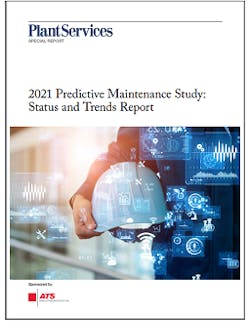4 need-to-know predictive maintenance tips from the experts
A successful predictive maintenance program can change you and your team from firefighters to proactive maintenance experts. It also is true that is can be difficult to avoid the numerous and costly pitfalls of implementation and continued operation. There is no one-size-fits-all solution for all facilities, and drafting the PdM plan that works for you can be intimidating.
With the right insight and advice, you can tailor your PdM program to your plant’s needs and avoid the all-too-common hazards along the way. Below are four foundational pieces of advice from our experts on how to establish and sustain your predictive maintenance program.
Establishing a predictive maintenance program
There are some essential facts that you must consider and evaluate when establishing a predictive maintenance program. The first, and maybe the most important, is this: Who is going to do the testing and monitor the program? Do you have the personnel, and do they have the time? Available labor hours can be a huge issue, and often in setting up a new PdM program, the hiring of several new technicians is deemed necessary. In some cases, it may be more realistic to consider outsourcing some or all of your predictive maintenance technologies. New technologies may require extensive and varied training. Are you willing to hire new people and spend the time and money necessary to train them? Undertrained technicians are a major problem throughout industry, partially due to the “hidden” cost associated with state-of-the-art technologies. For instance, vibration analysis training requires years of practical hands-on use and several levels of competency before a technician can be fully capable of making accurate calls.
Besides considering personnel matters, another important step is to define the issues that are important to your operation. Identify problem areas by reviewing past issues, with emphasis on conducting root-cause analyses. Research all technologies and determine which would best help resolve those issues.
Timothy Thomas, Hibbs ElectroMechanical
The basics of setting up an effective PdM program
Fail to plan...plan to fail
Plant personnel who fail to properly implement proactive maintenance techniques often find themselves in reactive mode. When a crisis occurs, maintenance staff must focus their attention and resources on a specific piece of equipment, sometimes at the expense of other machinery. This can put manufacturers in perpetual catch-up mode, leading to loss of productivity and profits. On the flip side, overmaintaining equipment can lead to wasted money and resources – this is traditionally where a PM optimization may be recommended.
So, how do you strike a balance? In today’s competitive marketplace, more manufacturers are beginning to implement condition monitoring and predictive maintenance to help avoid unplanned downtime and improve overall equipment effectiveness on the plant floor. Maximizing productivity involves more than just conducting routine maintenance – it requires using condition monitoring tools such as smart sensors connected to mobile apps to help plant managers promptly predict machinery issues before they affect operations. From a reliability perspective, looking at this on a P-F curve [showing potential failure (P) to failure (F)] using these new technologies will help you identify these potential premature failures and mitigate them before they start manifesting themselves as audible noise and heat-related issues.
Josh Flemming, SKF, and Paul Craven, Motion Industries
Predictive maintenance at your fingertips
Quantifying the value of PdM
Many of us maintainers are in a constant struggle to prove the value of our preventive and predictive maintenance programs. On one hand, these programs can be seen as a cost driver since a good inspection is intended to identify more work not reduce work. At face value, PM and PdM programs can appear to some managers to cost more to have the program and, in fact, is part of the reason inspections are sometimes reduced during times of cost reduction selections. So how do we show that we are in fact saving money instead? We must first make sure we identify that these programs are generating valuable work. We then need to communicate how that work equates to a cost avoidance.
A simple way to accomplish this is through the SMRP Metric 5.4.12 PREVENTIVE MAINTENANCE & PREDICTIVE MAINTENANCE YIELD. The intent of the metric is to show the ratio of corrective work identified based on the amount of PM / PdM work that is completed. This metric can be measured as just PM and just PdM separately, or by combining them both into one single metric.
Rick Clonan, CMRP, RMIC, Eruditio
How to frame the value of PM and PdM
IIoT deployment in collaboration with your PdM program
The main purpose of a PdM system in most cases is to avoid unexpected equipment failure to minimize plant downtime. Therefore, the cost of a motor or pump or compressor that is being monitored is typically not as important as the function it performs in the manufacturing process. A cost per hour for each area of the operation or each process will be very helpful as well as an overall cost per hour for the entire facility. Those figures will be used in ROI calculations when creating your PdM strategy.
Simply deploying sensors and collecting vast amounts of data is not enough. Because of the ease of use of cloud-based platforms, it is very tempting to collect data as often as possible “just in case.” Managing and interpreting the large amounts of data collected can become a very difficult and costly task. It is therefore important to only collect relevant data to perform the required analysis. One may start with collecting data at a high rate and then once the system behavior is understood, reduce the rate to a level that is enough to perform the required analysis.
Pranesh Rao, Thomas Schardt, Nidec Motor Corp; and Justin Lesley, Motion Industries
Practical magic: Integrating IIoT into your PdM strategy


